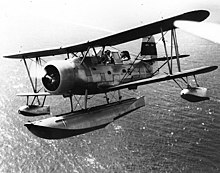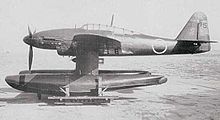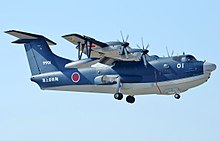User:Yiba/sandbox/Observasion seaplane

Observation seaplanes are military aircraft with flotation devices allowing them to land on and take off from water. Many were designed to be carried aboard warships, but they also operated from seashore harbors and sometimes from submarines. They typically had machine guns and could mount small bombs, with a crew of 1 to 3.
Purpose and history
[edit]
Their primary purpose started as the gunnery spotter function of 1. Locating targets, 2. Fall of shot observation for trajectory correction of large caliber naval artillery, and 3. Enemy damage assessment, when the range of 12" and larger guns on battleships increased beyond 5–6 km before the Battle of Jutland(1916) making the splash identification by the spotters on the mast difficult. During World War I, other usefulness were found such as 4. Position recording for a torpedo kill-shot from a submarine on disabled enemy capital ship, 5. Search and rescue missions, and 6. Air cover for infantry landing operations.[1]
In the World War II, the advent of a radar and aircraft carriers made flying near enemy fleet for spotter functions unrealistic. However, support functions became more important including 7. Reconnaissance / Photo intelligence gathering, 8. Liaison, and 9. Radio communication support for local activities including amphibious operation.
Operating procedure
[edit]
The engine is warmed up, or engine oil is pre-heated. The pilot and observer would climb into their aircraft and rev the engine at full throttle. If the instrument panel readings were satisfactory, the pilot would brace for takeoff and signal the catapult operator he was ready. The United States Navy 30 ft (9.1 m) catapult used a smokeless powder charge to accelerate the plane to 80 mi (130 km) per hour.[2] (0 to 80 in 1-1/2 seconds)
A capital ship preparing to recover its aircraft would steam into the wind and signal the aviator which way it would turn across the wind to provide a sheltered landing surface. When the plane was in position the ship would turn so the plane could land on the lee side as close as possible to the ship. The ship would tow a net along the water surface from a boom on the lee side, and the plane would taxi over the net so a hook on the underside of the float would engage the net allowing the plane to cut power and minimize relative movement of the plane with respect to the ship while the ship's crane hoisted the plane aboard.[2]
United States
[edit]
Two early aircraft assembled by Glenn Curtiss prior to formation of the Curtiss Aeroplane and Motor Company arrived aboard USS Mississippi on 24 April 1914 under the command of Henry Mustin to conduct aerial reconnaissance during the United States occupation of Veracruz. This was the first operational use of naval aircraft and the first time U.S. aviators of any service were the target of ground fire.[3] On 5 November 1915 Mustin pioneered United States Navy catapult operations piloting an AB-2 seaplane launched from the cruiser USS North Carolina. Interest in aerial observation increased as combat experience during first world war naval engagements demonstrated the inability of shipboard observers to accurately report fall of shot from the engagement range of dreadnought battleships. Nine Vought VE-7s were delivered in 1924 to be launched from battleship catapults. Subsequent design improvements were the Vought FU and Vought O2U Corsair. A few Berliner-Joyce OJ float planes were built for the Omaha class light cruiser catapults. The Curtiss SOC Seagull became the dominant United States Navy catapult seaplane in 1935, until the number of Vought OS2U Kingfishers manufactured during the second world war exceeded the total production of all previous United States Navy observation seaplanes. In the absence of gunnery engagements with other warships, capital ships' observation seaplanes were used to spot naval gunfire support; but they proved so vulnerable to land-based fighters during the amphibious invasion of Sicily that their pilots flew conventional fighters spotting gunfire for the invasion of Normandy. A few Curtiss SC Seahawks remained operational into the late 1940s until helicopters became reliable enough to replace observation seaplanes.[2]
United Kingdom
[edit]

The first seaplane used in a naval battle was a Short Type 184 launched from HMS Engadine in the opening stages of the 1916 Battle of Jutland. The plane was forced down by a broken fuel line after locating a few cruisers, and the clumsy procedure of finding calm water to offload and launch took so long that Engadine's other planes were unable to meaningfully participate.[4] This experience encouraged development of the Fairey III to be operated from aircraft carriers. The Supermarine Seagull II was the first British aircraft to be catapult launched in 1925. This design was improved as the Supermarine Walrus serving aboard capital ships of the Royal Navy through the second world war. Royal Navy preference for the newer Sea Otter's flying boat fuselage was unusual among the shipboard observation seaplanes of the major naval powers.
Japan
[edit]

When the Washington Naval Treaty left Japan with fewer capital ships than the United States or the United Kingdom, the country focused on aviation as a means of balancing naval power. Although only the Mitsubishi F1Ms were officially designated observation seaplanes, there were numerous similar reconnaissance seaplanes prefixed with the letter E rather than F. Japan produced observation and reconnaissance seaplanes in larger numbers and greater diversity than any other nation.
The first Japanese design was the Nakajima E2N in 1927. Increasing numbers of Nakajima E4Ns, Kawanishi E7Ks, and Nakajima E8Ns were manufactured before the Aichi E13A was produced in similar numbers to the American OS2U Kingfisher. Each of the Tone class cruisers carried six seaplanes for the Kidō Butai reconnaissance role to allow the full complement of aircraft carrier planes to focus on their attack role. In addition to launching from capital ships, these Japanese seaplanes operated from fast seaplane tenders providing aviation support similar to aircraft carriers during fleet activities and amphibious operations.[6]
Imperial Japanese Navy formalized B(Shipboard Attackers), C(Shipboard Reconnaissance), D(Shipboard Bomber), E(Reconnaissance Seaplane), F(Observation Seaplane), H(Flying Boat), N(Fighter Seaplane), R(Land-based Reconnaissance), Q(Maritime Patrol) and M(Special Purpose) classifications among others in the 1920s with different and overlapping requirements.
F Class
[edit]The F class planes were required to fly and climb fast with a level of defense including armament and in-combat maneuverability. This requirement was not only for the traditional spotter functions but also for 1. Air cover for local operations away from a fleet, and 2. Repelling of enemy reconnaissance planes.[7] In contrast, a long operational range was the C, E, R and Q class primary requirement with less regard to armament and maneuverability.
Ministry of Navy issued a design request based on the F requirement in 1935, and comparative evaluation was carried out among F1A(Aichi), F1M(Mitsubishi) and F1K(Kawanishi) in flight testing. After a modification, Mitsubishi F1M won the Navy production contract with excellent climb rate and maneuverability, and went into service in 1941 with a formal Navy type designation "Type Zero Observation Aircraft". For a plane with floats, F1M2 performance was beyond expectations at the time with 9min36sec to 5000m climb rate, and especially its maneuverability in dog-fights where pilots rated it superior to the Zero Fighter-converted fighter seaplane A6M2-N, which often surprised the US fighter pilots in the early stages of the Pacific Theater of WWII.[7]


The 3 machine gun armament, high rate of climb and maneuverability of F1M2 proved versatile for liaison and search & rescue purposes as well in the deteriorating trends in the war with a good survivability, and the biplane remained onboard cruisers and battleships until the end of the war in 1945. Because of the success of F1M2 design, no further design request in this category was issued by the Navy.[7] However, more armament and speed were increasingly required for the E Class in the later stages of war.
Submarine-based Seaplane
[edit]This class of seaplanes was not pioneered in Japan (Cox-Klemin XS was made in the US in 1922, British Parnall Peto flew in 1925, and Arado Ar 231 was tried in 1941 by Germany) but this category uniquely reached deployment in Japan. The Yokosuka E6Y, Watanabe E9W and Yokosuka E14Y were specially designed to be carried and launched by submarines,[8] and this series was further developed into submarine launched dive bomber / torpedo attacker Aichi M6A with maximum speed of 474 kilometres per hour (295 mph) and over 1,100 kilometres (680 mi) range, that was more than capable of observation/reconnaissance roles.
Germany
[edit]
German rearmament in the 1930s included Heinkel He 60, Heinkel He 114 and Arado Ar 196 float planes for launch from the catapults of the Kriegsmarine's capital ships. A few later operated aboard merchant raiders.[9]
Comparison of ship-launched seaplanes
[edit]The following is not an exhaustive list, but compares the observation and reconnaissance seaplanes produced in greatest numbers.
| Name | Nation | Type | Range | Max Speed | Machine Guns | Produced | Number built |
|---|---|---|---|---|---|---|---|
| Kawanishi E7K | Japan | Twin-float biplane | 1375 mi. | 171 mph | 3 x .303" | 1935-1941 | 733[10] |
| Curtiss SOC Seagull | United States | Single-float biplane | 675 mi. | 165 mph | 2 x .30" | 1935-1940 | 322[11] |
| Nakajima E8N | Japan | Single-float biplane | 558 mi. | 190 mph | 2 x .303" | 1935-1940 | 755[12] |
| Supermarine Walrus | United Kingdom | Biplane flying boat | 600 mi. | 135 mph | 2 x .303" | 1936-1944 | 775[13] |
| Arado Ar 196 | Germany | Twin-float monoplane | 670 mi. | 193 mph | 2 x 7.92mm, 2 x 20mm | 1938-1944 | 541[14] |
| Vought OS2U Kingfisher | United States | Single-float monoplane | 908 mi. | 171 mph | 1 x .30" | 1940-1944 | 1519[11] |
| Mitsubishi F1M | Japan | Single-float biplane | 460 mi. | 230 mph | 3 x .303" | 1941-1944 | 944[15] |
| Aichi E13A | Japan | Twin-float monoplane | 1298 mi. | 234 mph | 1 x .303" | 1941-1944 | 1418[16] |
| Supermarine Sea Otter | United Kingdom | Biplane flying boat | 725 mi. | 163 mph | 1 x .303" | 1942-1945 | 292[13] |
| Aichi E16A | Japan | Twin-float monoplane | 731 mi. | 273 mph | 2 x 20mm, 1 x 13mm | 1944-1945 | 256[17] |
| Curtiss SC Seahawk | United States | Single-float monoplane | 625 mi. | 313 mph | 2 x .50" | 1944-1945 | 577[11] |
Modern Example
[edit]
ShinMaywa US-2 operated by Japan Maritime Self-Defense Force is used for search and rescue missions in high water, and its variant hauls 15 tons of water for fighting forest fire.
Sources
[edit]- ^ Imai, Jin (1953). Complete Overview of Japanese Military Planes (in Japanese). Kantosha. pp. 147–149.
- ^ a b c Stinson, Patrick (1986). "Eyes of the Battle Fleet". Proceedings. Supplement (April). United States Naval Institute: 87–89.
- ^ Owsley, Frank L., Jr.; Newton, Wesley Phillip (1986). "Eyes in the Skies". Proceedings. Supplement (April). United States Naval Institute: 17–25.
{{cite journal}}: CS1 maint: multiple names: authors list (link) - ^ Potter, E.B.; Nimitz, Chester W. (1960). Sea Power. Englewood Cliffs, New Jersey: Prentice-Hall. p. 635.
- ^ Watts, Anthony J. (1967). Japanese Warships of World War II. New York: Doubleday & Company. pp. 311–315.
- ^ Dull, Paul S. (1978). A Battle History of the Imperial Japanese Navy (1941-1945). Annapolis, Maryland: Naval Institute Press. pp. 14, 55, 71, 72 & 114.
- ^ a b c Watanabe, Yoji (2000). Struggling in the Overtaxed Airspace (in Japanese) (Kojinsha NF Collection ed.). Koujinsha. ISBN 4-16-724909-X.
- ^ Collier, Basil (1979). Japanese Aircraft of World War II. New York: Mayflower Books. pp. 46, 59, 62, 101, 119 & 137. ISBN 0-8317-5137-1.
- ^ Wood, Tony; Gunston, Bill. Hitler's Luftwaffe. New York: Crescent Books. pp. 126 & 185. ISBN 0-517-22477-1.
- ^ Collier, Basil (1979). Japanese Aircraft of World War II. New York: Mayflower Books. pp. 62 & 63. ISBN 0-8317-5137-1.
- ^ a b c Morison, Samuel Eliot (1962). History of United States Naval Operations in World War II. Vol. Fifteen. Boston: Little, Brown and Company. p. 114.
- ^ Collier, Basil (1979). Japanese Aircraft of World War II. New York: Mayflower Books. pp. 119 & 120. ISBN 0-8317-5137-1.
- ^ a b Gunston, Bill (1989). Jane's Fighting Aircraft of World War II. New York: Crescent Books. pp. 142 & 143. ISBN 0-517-67964-7.
- ^ Wood, Tony; Gunston, Bill (1977). Hitler's Luftwaffe. New York: Crescent Books. pp. 126 & 127. ISBN 0-517-22477-1.
- ^ Collier, Basil (1979). Japanese Aircraft of World War II. New York: Mayflower Books. p. 101. ISBN 0-8317-5137-1.
- ^ Collier, Basil (1979). Japanese Aircraft of World War II. New York: Mayflower Books. pp. 59 & 60. ISBN 0-8317-5137-1.
- ^ Collier, Basil (1979). Japanese Aircraft of World War II. New York: Mayflower Books. p. 60. ISBN 0-8317-5137-1.
